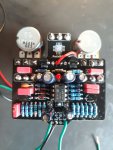Hi everyone, this is my first post here,
I built a Oasis today but the gain knob seems to be stuck on a certain value. Turning it has no effect on the amount of clipping, I just get a very soft overdrive.
I measured the value of the gain knob (on the circuit but I mostly wanted to see if it was doing its job) and the value is changing as I turn the knob like it's supposed too.
Populated the PCB went smooth, except maybe for the D5 (the LED) because the cathode/anode orientation got me a little confused and I had to remove it and put a new one in the orientation. Could it be something there?
If you guys have any input on where I should start looking, shoot!
thanks a lot
gregDS
I built a Oasis today but the gain knob seems to be stuck on a certain value. Turning it has no effect on the amount of clipping, I just get a very soft overdrive.
I measured the value of the gain knob (on the circuit but I mostly wanted to see if it was doing its job) and the value is changing as I turn the knob like it's supposed too.
Populated the PCB went smooth, except maybe for the D5 (the LED) because the cathode/anode orientation got me a little confused and I had to remove it and put a new one in the orientation. Could it be something there?
If you guys have any input on where I should start looking, shoot!
thanks a lot
gregDS



